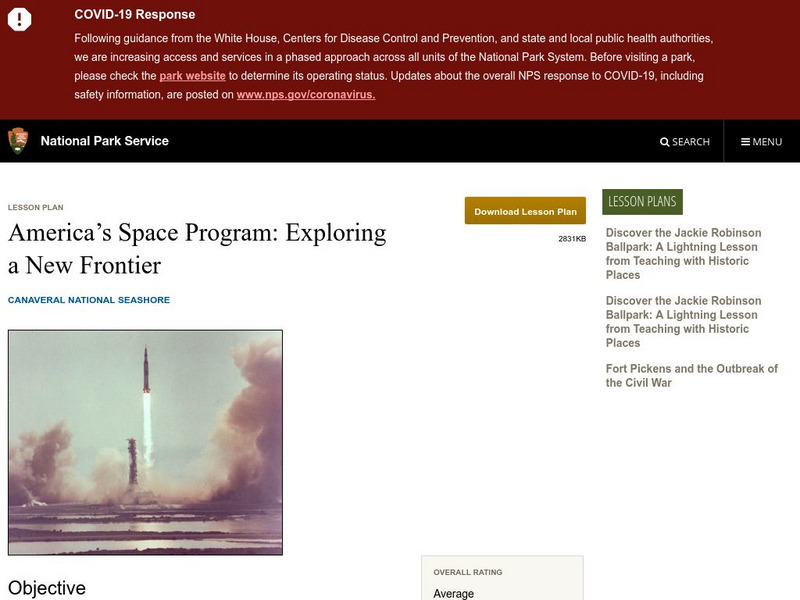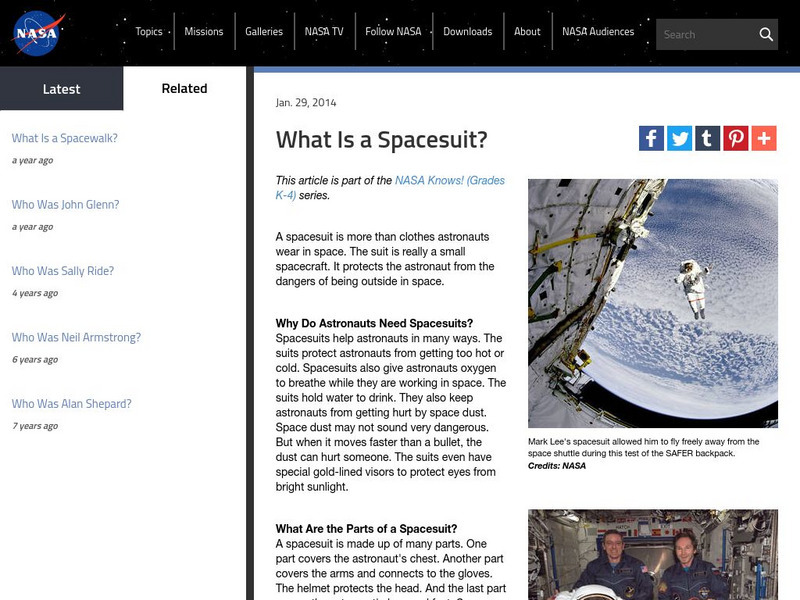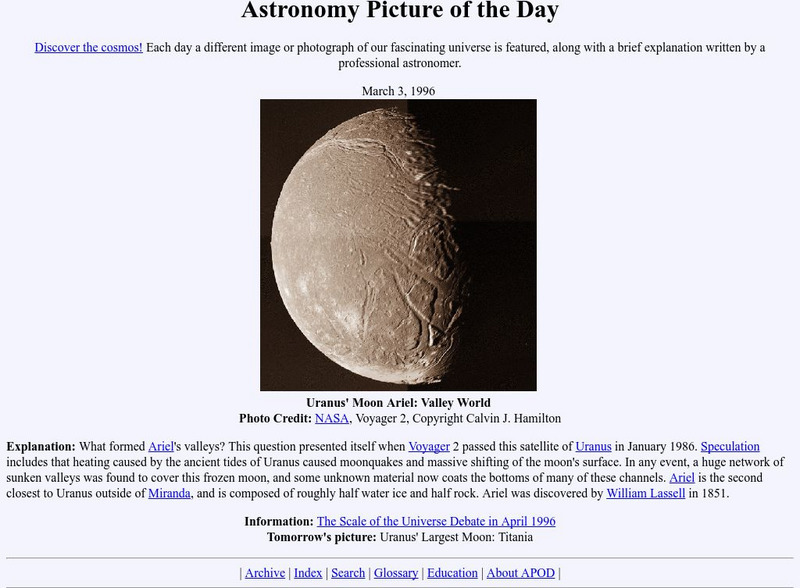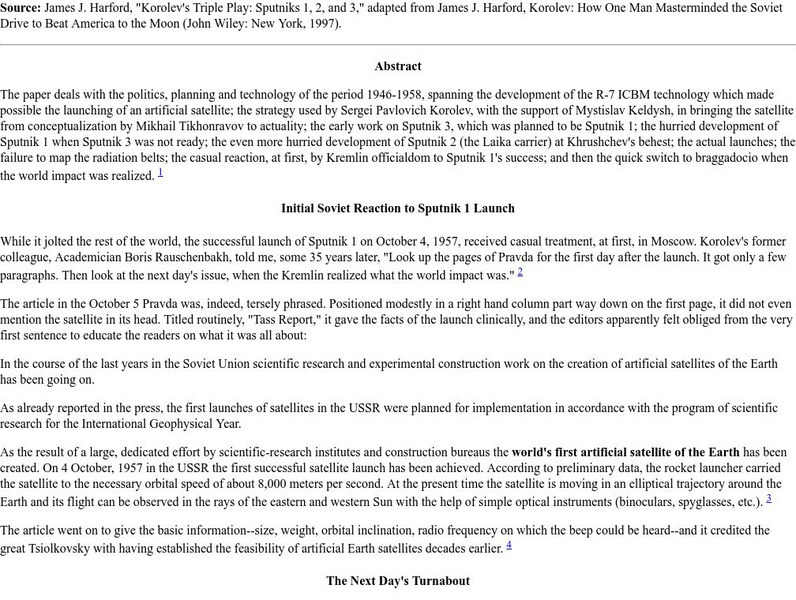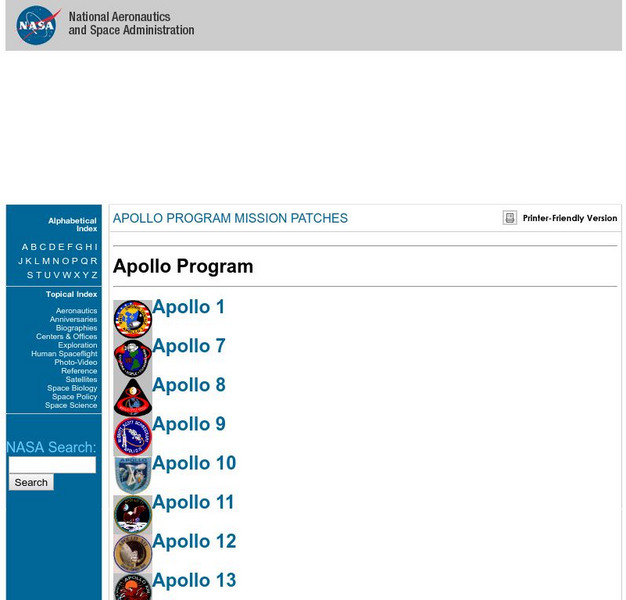Hi, what do you want to do?
A&E Television
History.com: How Many Times Has the u.s. Landed on the Moon?
Among seven Apollo moon landing missions, only one did not land men on the moon. Apollo 11 lunar module on July 20, 1969 to become the first human being to step foot on the moon. "That's one small step for man, one giant leap for...
A&E Television
History.com: The Soviet Response to the Moon Landing? Denial There Was a Moon Race at All
Until 1989, Russians claimed they were not trying to reach the Moon first and that the U.S. was in "a one-nation race." Until 1989, a group of American aerospace engineers went to Moscow and finally saw the Soviets' failed lunar-landing...
Curated OER
National Park Service: America's Space Program Exploring a New Frontier
This site includes a lesson for teachers to use when teaching about America's space program. Also included is the history of the space program, maps, readings, images of the space program, and benefits that resulted from space research.
NASA
Nasa: The First Lunar Landing
This site from NASA is extensive and contains a deep supply of information about the historical moon landing. Click on "Table of Contents" to proceed through the site. Wonderful images!
NASA
Nasa: Wernher Von Braun
NASA profiles Wernher von Braun, "one of the most important rocket developers and champions of space exploration during the period between the 1930s and 1970s."
NASA
Nasa: What Is a Spacesuit?
This small collection of questions and answers introduces students to spacesuits: what they are, how they help astronauts, and what their important parts are. View two photos, and follow links to FAQs about spacesuit use, construction,...
NASA
Nasa: Tests Versus Time in the Race for Space
This NASA site offers a good description of the ongoing space race during the Kennedy administration, discussing the "nip and tuck" of the Soviet-U.S. race. Also includes a description of Kennedy's new special assistant for science and...
NASA
Nasa: Astronomy Picture of the Day: Uranus's Moon Ariel
Provides a brief overview of Ariel, one of Uranus's moons. Details how its deep valleys were formed. A NASA astronomy picture of the day.
Computer History Museum
Computer History Museum: Model 7094 Console
Brief description of the Model 7094 Console, a transistor computer used in the NASA Apollo space program. The machine is on display at the Computer History Museum. This site provides a glimpse into the development of the information age...
NASA
Nasa: Sputniks 1, 2, and 3
NASA provides a paper that "deals with the politics, planning and technology of the period 1946-1958" in the Sputnik program.
NASA
Nasa: "Pravda" Press Release
NASA provides the full text from the tersely worded "Pravda," the Russian national newspaper, that announced the successful launch of Sputnik.
NASA
Nasa: Apollo Lunar Surface Journal
NASA provides a record of the six Apollo landings on the Moon. This site provides transcripts of communications between the astronauts and mission control. Commentary by the astronauts and the journal editor is included.
NASA
Nasa: Apollo Lunar Surface Journal: Portable Life Support System
This site provides detailed technical diagrams of space suit components and very detailed explanations of how the Apollo Moon suits worked. Detailed close-up photographs of parts of the space suit are provided. You could probably build...
NASA
Dawn Mission: Dawn Classrooms: The History and Discovery of Asteroids
Student groups explore scientific breakthroughs and the development of technologies that eventually led to asteroid discovery aboard the Dawn space mission. Learning module components include jigsaw reading, model building, math...
Smithsonian Institution
National Museum of Natural History: Ocean Planet: Ocean Currents
The Ocean Planet exhibit at the Smithsonian explains the general features of ocean circulation. A general look at upwelling, deep water, and currents are combined for an overall view.
TeachEngineering
Teach Engineering: Mission to Mars
The Mission to Mars curricular unit introduces students to Mars-the Red Planet. Students discover why scientists are so interested in studying this mysterious planet. Many interesting facts about Mars are revealed, and the history of...
Smithsonian Institution
National Museum of Natural History: Ocean Planet
Detailed website that was a companion to a 1995 traveling exhibit of the Smithsonian. Links to lesson plans and other educational materials are at the bottom of the page. Enter the exhibition to explore the world of the ocean.
Other
The Space Race
Although the space race was originally a competition between two Cold War foes,it ultimately resulted in many benefits for the people of the Earth. Find information on the Mercury, Gemini, and Apollo, and Soviet space programs,...
Smithsonian Institution
National Museum of Natural History: Ocean Planet: In Search of Giant Squid
An on-line exhibit archived from a Smithsonian exhibit explores and interprets the facts and myths surrounding giant squids - the world's largest invertebrates.
NASA
Lightning & Atmospheric Electricity Research at the Ghcc
This is the homepage for the Global Hydrology and Climate Center's Lightning Team. On this site, you will data from the Lightning Team's experiments; documents, reports, press releases, and an assortment of other information related to...
NASA
Nasa: Imagine the Universe: Gamma Ray Astronomy Satellites and Missions
"We present the many satellites which have detected electromagnetic radiation through the 1960s, 70s, 80s, and 90s." Visit this site to read more about the development of satellites throughout the history of gamma-ray astronomy. Graphics...
NASA
Nasa Space Place: All About Earth
Brief description of the earth's structure, surface, neighbors, and history with images.
NASA
Jpl: Voyager: The Interstellar Mission
The Jet Propulsion Laboratory (JPL) at NASA provides a detailed history of the Voyager Project, including a description of the spacecraft and Voyager's planetary tour.
NASA
Nasa: Project Apollo Patches
This site from NASA provides illustrations of the Apollo Program mission patches worn by the astronauts and used by NASA in connection with each mission.






